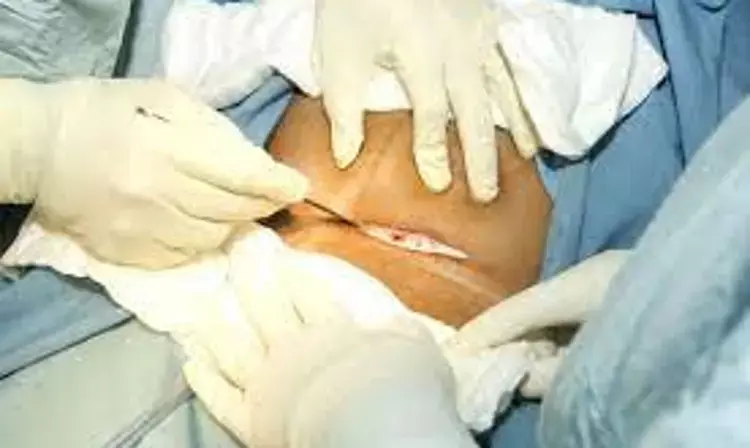- Home
- Medical news & Guidelines
- Anesthesiology
- Cardiology and CTVS
- Critical Care
- Dentistry
- Dermatology
- Diabetes and Endocrinology
- ENT
- Gastroenterology
- Medicine
- Nephrology
- Neurology
- Obstretics-Gynaecology
- Oncology
- Ophthalmology
- Orthopaedics
- Pediatrics-Neonatology
- Psychiatry
- Pulmonology
- Radiology
- Surgery
- Urology
- Laboratory Medicine
- Diet
- Nursing
- Paramedical
- Physiotherapy
- Health news
- Fact Check
- Bone Health Fact Check
- Brain Health Fact Check
- Cancer Related Fact Check
- Child Care Fact Check
- Dental and oral health fact check
- Diabetes and metabolic health fact check
- Diet and Nutrition Fact Check
- Eye and ENT Care Fact Check
- Fitness fact check
- Gut health fact check
- Heart health fact check
- Kidney health fact check
- Medical education fact check
- Men's health fact check
- Respiratory fact check
- Skin and hair care fact check
- Vaccine and Immunization fact check
- Women's health fact check
- AYUSH
- State News
- Andaman and Nicobar Islands
- Andhra Pradesh
- Arunachal Pradesh
- Assam
- Bihar
- Chandigarh
- Chattisgarh
- Dadra and Nagar Haveli
- Daman and Diu
- Delhi
- Goa
- Gujarat
- Haryana
- Himachal Pradesh
- Jammu & Kashmir
- Jharkhand
- Karnataka
- Kerala
- Ladakh
- Lakshadweep
- Madhya Pradesh
- Maharashtra
- Manipur
- Meghalaya
- Mizoram
- Nagaland
- Odisha
- Puducherry
- Punjab
- Rajasthan
- Sikkim
- Tamil Nadu
- Telangana
- Tripura
- Uttar Pradesh
- Uttrakhand
- West Bengal
- Medical Education
- Industry
Smaller interpregnancy interval linked to uterine rupture risk during labour after cesarean: Study

Smaller interpregnancy interval linked to uterine rupture risk during labor after cesarean suggests a new study published in the American Journal of Obestretics and Gynecology.
A study was done to describe the association between inter-pregnancy interval (IPI) and uterine rupture among individuals attempting TOLAC. This retrospective cohort study used US CDC data including birth and fetal death data files (2011-2021) and Period/Cohort Linked Birth-Infant Death Data Files (2014-2019). Participants had one previous livebirth by cesarean delivery (CD), no previous vaginal births and an immediately subsequent TOLAC. Rates of uterine rupture were described by IPI group and univariable logistic regression with first-order splines with one knot. Multiple imputation and multivariable logistic regression were used. Results: Among 42.5 million births, 506 666 TOLACs immediately after a CD were included in the multivariable logistic regression.The raw rate of uterine rupture was 0.40% for IPIs < 18 months (95%CI 0.37-0.44%) and 0.30% for IPIs ≥18 months (95%CI 0.28-0.32%). The Figure shows rates of uterine rupture by IPI and the predicted probabilities of rupture in the univariable spline regression for induced/augmented and spontaneous labors. There was a linear decrease with increasing IPI until 18 months and subsequent relatively constant rates. The odds ratio was 1.94 for an IPI < 3 months (95%CI 1.73 to 2.06), progressively decreasing to 1.15 for an IPI from 15 to < 18 months (95%CI 1.10 to 1.21) compared with IPI 4-5 years after adjusting for confounders. Uterine rupture was associated with increasing age, decreasing height, higher gestation, higher birthweight, and induced/augmented labors. It was not associated with hypertension, gestational diabetes or smoking. The rate of uterine rupture with stillbirth or neonatal death was 0.012% (1:8413) for IPI < 18 months (95%CI 0.00-0.02%) and 0.018% (1:5614) for IPI ≥18 months (95%CI 0.01-0.02%). Shorter IPI is strongly associated with an increase in uterine rupture in TOLAC with the odds ratio falling sharply between 0 and 18 months. An IPI of at least 18 months should be recommended to achieve the lowest incidence of uterine rupture during TOLAC.
Reference:
Bradley de Vries, Pejman Adily, Travis Bettison, Rajit Narayan, George Johnson, Marjan Mosalman Haghighi. 57 Inter-pregnancy interval and uterine rupture among more than 500,000 Trials of Labor after Cesarean (TOLAC). ORAL CONCURRENT SESSION 6 - QUALITY, EQUITY & PUBLIC HEALTH | WEDNESDAY, FEBRUARY 14 | 10:00 AM - 12:00 PM| VOLUME 230, ISSUE 1, SUPPLEMENT. American Journal of Obestretics and Gynecology. DOI:https://doi.org/10.1016/j.ajog.2023.11.078
Keywords:
Smaller interpregnancy interval, uterine rupture, risk, labor, cesarean, Bradley de Vries, Pejman Adily, Travis Bettison, Rajit Narayan, George Johnson, Marjan Mosalman Haghighi, American Journal of Obestretics and Gynecology
Dr. Shravani Dali has completed her BDS from Pravara institute of medical sciences, loni. Following which she extensively worked in the healthcare sector for 2+ years. She has been actively involved in writing blogs in field of health and wellness. Currently she is pursuing her Masters of public health-health administration from Tata institute of social sciences. She can be contacted at editorial@medicaldialogues.in.
Dr Kamal Kant Kohli-MBBS, DTCD- a chest specialist with more than 30 years of practice and a flair for writing clinical articles, Dr Kamal Kant Kohli joined Medical Dialogues as a Chief Editor of Medical News. Besides writing articles, as an editor, he proofreads and verifies all the medical content published on Medical Dialogues including those coming from journals, studies,medical conferences,guidelines etc. Email: drkohli@medicaldialogues.in. Contact no. 011-43720751


